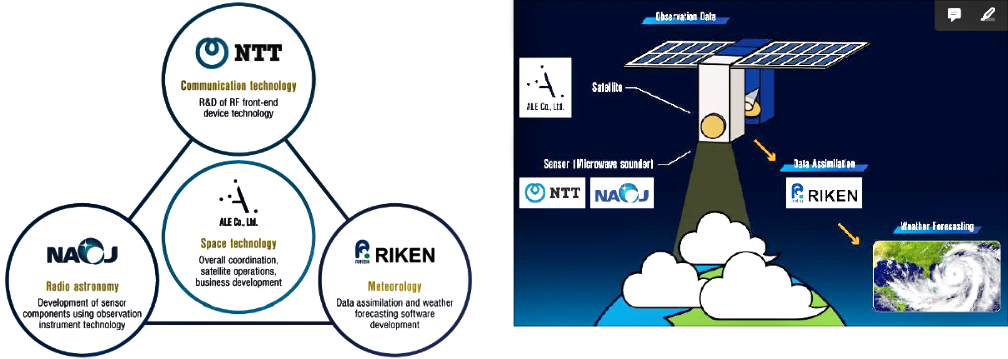
ALE Co., Ltd.(ALE) has signed a memorandum of understanding (MOU) and joint research agreements for the development of weather satellites with NTT Device Technology Laboratories, NTT Corporation (NTT), RIKEN Center for Computational Science, and National Astronomical Observatory of Japan (NAOJ) and has initiated AETHER, an Industry-Academia collaboration project to tackle natural disasters with commercial weather satellites.

In recent years, the severity of natural disasters has been increasing around the world. In particular, the impact of disasters related to climate change is significant, with economic losses amounting to$2,245 billion (77% of all natural disasters) over the past 20 years. Due to geographic factors, Asia is more susceptible to natural disasters, and Japan, completely surrounded by water, is one of the most affected countries
To cope with these geographical conditions, the company has launched the Industry-academia collaboration project, AETHER, to reduce unreasonable damage from disasters by using data from space. By developing an original, small sensor for Earth Observation (EO) and acquiring atmospheric data from space with a weather satellite equipped with this sensor, the accuracy of weather forecasts can be improved.
These satellites were developed by bringing together the participating organizations and using their expertise in their respective fields to ultimately provide weather information suitable for the current global environment to Japan, a country prone to disasters. AETHER will be the first Japanese project to acquire observation data for weather forecasting with a commercial weather satellite.
Ideally, weather forecasting should be based on a wide range of stable observations ,regardless of location or time. Having said that, observation data taken from above the sea is not sufficient, as the observation methods are limited compared to those acquired from land. In the case of island nations such as Japan, acquiring a wide range of data, including from above the ocean ,is paramount for weather forecasting in coastal regions.
Satellites are suitable for continuous observation of a wide area under such conditions and, until now, large government satellites have played this role and contributed to weather forecasting. However, large satellites are expensive to manufacture and operate and it is not easy for the government to continue to operate them with a limited national budget.
On the other hand, weather forecasting is becoming more and more important due to the increasing number of natural disasters. For example, heavy rains and typhoons are phenomena for which it is important to have atmospheric data several hours to multiple days ahead of their occurrence, which is a relatively short period of time for weather forecasting. In order to improve the forecasting of these phenomena, more frequent and detailed data is required. Thus, more frequent and detailed data will demand the improvement of technology and the enhancement of related infrastructure.
AETHER will use a cubesat to drastically reduce the cost from hundreds of millions of dollars to millions of dollars per satellite, or from billions of dollars to tens of millions of dollars per project, a reduction of about 1/100. In addition, the company will develop a “microwave sounder” for this smallsat sensor to observe water vapor and temperature, important factors for weather forecasting, in the atmosphere day and night, regardless of weather conditions, one of the most important factors for weather forecasting.
With this additional data, ALE will be able to contribute to disaster prevention and mitigation as part of the commercial sector. Providing more frequent and additional observational data, we can complement the government’s large satellites by creating a smallsat constellation.
In AETHER, organizations specialized in each field have come together and established an integrated research and development system, ranging from observation to forecasting. NTT and NAOJ are in charge of the research and development of the core components of the small microwave sounder using sub-millimeter wave-band device technology in communication field and receiver technologies used for observation instruments in radio astronomy, respectively.
RIKEN will develop software for data assimilation and weather forecasting using its meteorological knowledge of large computer systems such as the supercomputer “Fugaku“. ALE will be in charge of the overall coordination of hardware and satellite operations using space technology cultivated in other projects and will also oversee the business aspects of AETHER in order to connect the technologies and knowledge of each organization to the new meteorological business.
The first step will be to develop elemental technologies, followed by a ground demonstration using a prototype, with the goal of a space demonstration within five years. Eventually, we plan to provide weather-related services from observation data to solution services based on weather forecasts.
